The Gift of South Dakota
Subscriptions to South Dakota Magazine make great gifts!
Subscribe today — 1 year (6 issues) is just $29!
Clamming on the James
Clams once thrived in the clean, steady waters of the James River
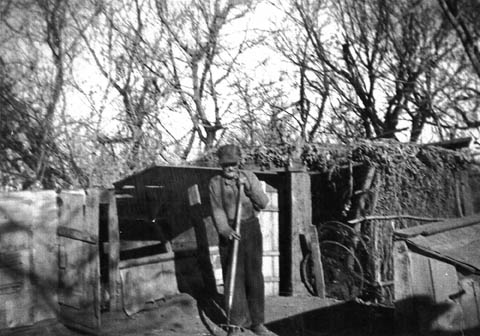 |
| Clamming pioneer "Fisher Bill" Richards spent most of his life digging clams and living in a tent along the James River. |
Clams still lie in the beds of some South Dakota rivers and lakes, but 100 years ago they filled the James River and created a thriving business. People from Mitchell to Yankton spent summers prying the mussels from the muddy river bottom and then sent the shells east to become pearl buttons.
Families set up summertime clamming camps along the river. A hub developed near Tuscan, a water station about four miles southwest of Menno in Hutchinson County where the river and railroad met. Trains got water for the steam engines and clammers loaded their harvest into railcars, which took them to button factories in towns along the Mississippi River like Muscatine (the Pearl Button Capital of the World), Davenport and Guttenberg in Iowa.
Clammers were busy on other area waters, like the Vermillion and the Minnesota River across the border in Yellow Medicine County, Minn., but the demand for clamshells and the abundance of mussels in the James River made Tuscan the “Mother of Pearl Capital of the World” by the 1890s. Trains regularly left Tuscan loaded with clamshells. Once the Hutchinson Herald reported a train headed east with 17 boxcars full of shells, worth $35 per ton.
The murky Missouri River held few clams. “At one time the Missouri River was the ‘Big Muddy,’” says Doug Backlund, a wildlife biologist with the state Game, Fish and Parks department’s Natural Heritage Program. “It was a big, turbid river with a shifting bottom. That’s not a good habitat for clams. Clams like clear streams with a fairly firm substrate that doesn’t shift around a lot.” Hundreds of years ago, the Missouri’s tributaries in southeastern South Dakota — the James, Vermillion and Big Sioux rivers — were cleaner and more stable, providing prime habitats for clams that arrived attached to fish and then burrowed into the river bottom.
Robert Coker and John Southall, working for the U.S. Bureau of Fisheries, explored the James River’s mussel beds from its source in North Dakota to its mouth southeast of Yankton in the summer of 1913. They found few decent shells until they reached Riverside, near Mitchell, where they discovered a large commercial shelling operation. A pair of fishermen there took 20 tons of shells from the river. Three miles downstream another man had harvested 15 tons. The busiest stretch of the river was from Milltown to Yankton, where clammers dug 400 tons of shells by the time Coker and Southall visited late in the season.
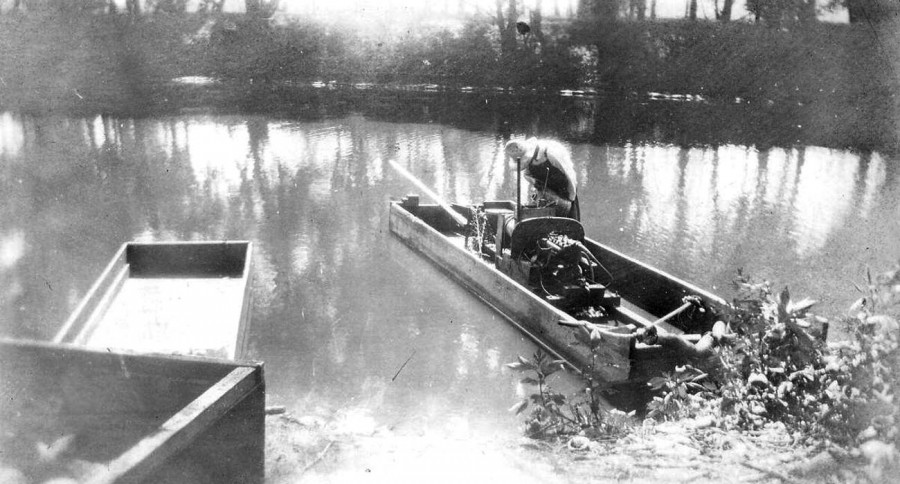 |
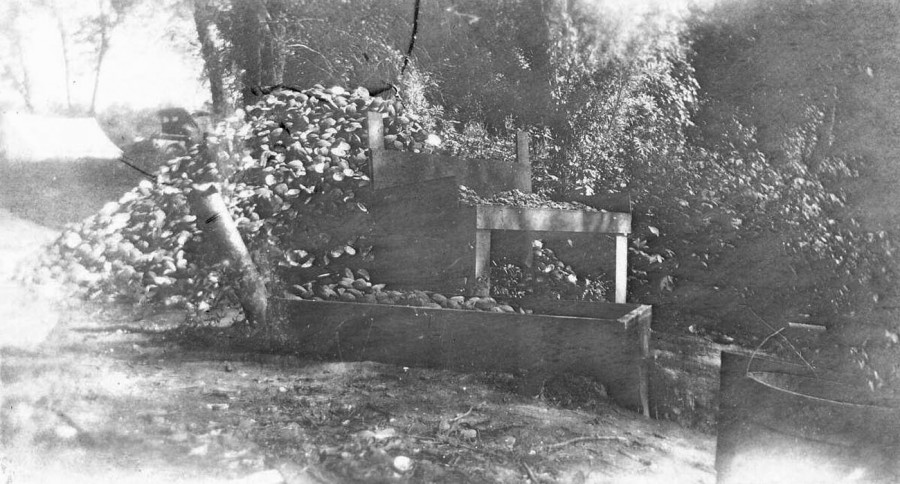 |
| Arnold Diede built boats (top) for he and his wife, Evelyn, to use during clamming expeditions near Menno, South Dakota. After cleaning clams, they piled shells at their camp near Milltown (bottom) before trains carried them East to button factories. |
Arnold and Evelyn Diede were newlyweds when they began clamming near Menno in 1929. That spring Arnold built a boat using the engine from a Ford car. He fashioned a digger out of a 2x4, an iron shovel and a hand-woven basket that could hold 100 pounds of clams. The Diedes attached the digger to the front of the boat and Arnold pried clams from the mud while Evelyn drove.
“Arnold would drop the digger to the bottom of the river, the power of the motor pulling the digger along on the bottom of the river as we rode over the clam bed,” Evelyn wrote in a family history book years later. “By holding the handle Arnold could feel what sort of clam bed it was, how long and wide, also how deep. When the basket was full, he would tell me to turn around on the river and as I did so, it aided Arnold in lifting up the full basket. He then would dump the clams onto the boat and lower the basket again and I would follow the same line we had taken before and repeat the whole process.”
Another method was used for clams in shallow water. The Diedes ran a small boat and dug them out by hand. “We used to wade in mud 4 to 6 inches deep,” Evelyn recalled. “It seemed we always had clothes hanging on the line.”
When the boat was fully loaded they returned to their riverside camp. The Diedes used a homemade cooker placed over an 18-inch deep pit near the riverbank to steam the clams open. Then they removed the meat and threw the shells in a pile. Farmers used the discarded meat as pig feed, while rotten meat became catfish bait. Buyers paid the Diedes $25 to $35 per ton for their clamshells, depending on the quality.
Clamming attracted unique characters. Bill Richards, a clamming pioneer, spent much of his life in a tent by the river west of Menno. Known as “Fisher Bill,” Richards lived a rough life before moving to Tuscan. Originally from New York, he spent his early years in an Illinois orphanage. He ran away at age 14 and found work with a railroad crew at Council Bluffs, Iowa. One day a prairie fire burned him so badly his co-workers thought he was dead. He crawled to the Missouri River where a settler found him and cared for him until he regained his strength. Fisher Bill then went to Tuscan, where he spent years clamming and living year-round in the tent. When Bill was 80, townspeople convinced him to move the tent into Menno. He lived behind the funeral home, where a small creek and wooded area replicated his longtime home along the James. He died in 1954 at age 92.
Another clam fisherman was known as Swede Al. He worked the James River from its mouth to Mission Hill. Longtime Yankton County resident Paul Nelson remembered that Swede Al’s territory was limited because his big houseboat couldn’t fit under the railroad bridge west of town.
Nelson, born in 1915, grew up in a “tar paper shack” along the James River. He saw many clam boats, but Swede Al had the biggest operation. “Other people used to fish for clams, but not like he did,” Nelson said when South Dakota Magazine visited him before he died in 2009. “That was his life.”
Some clammers worked solely to find pearls. Fisher Bill found and sold a few pearls, as did the Diedes. One pearl looked like a strawberry and brought them $15. Evelyn had two silver rings made with small pearls. Nelson’s uncle and aunt, Matthew and Nancy Seddon, bought clam meat and pearls from Swede Al. Men searching for pearls on the Vermillion River at Centerville found $500 worth by the time Coker and Southall arrived.
But most Dakota pearls were poor. “They weren’t shaped well and they were colored,” Nelson told us. “They weren’t like the pearls that were on the market from oysters, but you could make a pretty good necklace.” Two-thirds of the pearls in the Riverside fisherman’s 20-ton haul were worthless. Evelyn Diede thought it was because valuable pearls are found in clearer water, and “Jim River water was always dirty and muddy,” she wrote.
Clamming boomed from the late 1800s through the early 1900s. Over harvesting and environmental changes nearly wiped out the James River’s clams by the 1940s. The railroad left and Tuscan disappeared. And the emergence of plastic buttons brought an end to the American clamshell button industry. In 2002 Backlund and Keith Perkins, a biology professor at the University of Sioux Falls, studied the James River’s mussel population. It was the first scientific study of its clams since Coker and Southall’s nearly 90 years earlier. They found live clams, but only a handful for every hour of searching, and many long dead shells, indicating their former abundance. Today one of the best places to find clams is in the Missouri River below Gavins Point Dam. The firm bottom and clean, warm water the dam releases create a perfect habitat. “The Big Muddy is now the nice, clear river with a good habitat for clams, and the Jim River and Big Sioux River have become turbid and muddy,” Backlund says. “There are still some species that thrive there, but not the same ones that used to be there.”
Though clamming on the James ended in the 1930s, artifacts from the era can still be found. The Menno Heritage Museum has a clamshell button display along with an old rake used for clam digging. Elmer Mueller, who lives southwest of Menno a quarter mile from the James River, has a few clamshells. He also found a clam rake along the riverbank near his home. And the Diedes’ granddaughter, Debbie Palmer, has a small jar of pearls Arnold and Evelyn found during their clamming summers. They’re all reminders of an era when people living in the James River valley could make money off corn, cattle or clams.
Editor's Note: This story is revised from the May/June 2009 issue of South Dakota Magazine. To order a copy or to subscribe, call 800-456-5117.


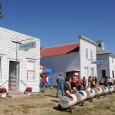




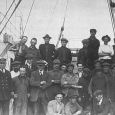


Comments
We recently ate a meal of linguini and clams- out of a can. Yummy but how wonderful to think we once could have used fresh clams from the Jim.. Thank you!